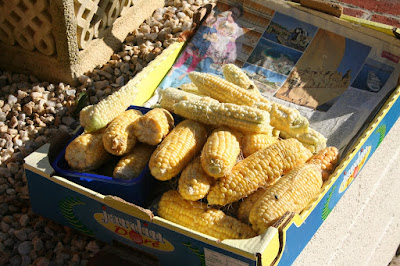Peter Mayle came to France to write a novel - he finally managed to publish his novel
Hotel Pastis four years after being distracted by the challenges of living in France and writing
A Year in Provence. Michael Wright came to the Limousin in France to keep sheep and ended up writing
C'est La Folie see
http://www.lafolie.co.uk/ for more information.
I'm
didn't come to France to write a book and I'm not planning to write one
- but if I did it would probably be called "Plaster - just why Britain
and France are so /different".
I've written before in
this blog about the differences between French and British plaster and
how this seems to be a metaphor for some of the wider cultural
differences between the two countries. We've been plastering again but
this time using imported British plaster. Getting the contrast between
the areas in the building that are new and sharp with the rougher finish
of the existing original walls is a challenge. I'm sure that
Kevin McCloud
would have a view on this but what we've decided to do is make the new
bits smooth and modern and the older original parts of the building will
have a more natural look. Going to one extreme or the other would be
wrong (risking on one hand a faux vintage look or a modern interior that
looks like it's been transplanted into a 250 year old building) so
we're walking the tightrope of compromise.
Hence, after
doing the old lean-to in French plaster we rumbled back from the UK in
August with three quarters of a tonne of British boardfinish plaster on
the trailer. This was to plaster the two end walls and the ceilings
downstairs so, nearly two years after fitting the ceilings in the house
we were back on the board lifter to install the barn ceilings. The
boardlifter had also come back on the trailer from the UK and was a
special 4.5m high lift version to (hopefully) allow us to install the
high ceilings upstairs. Even Gérard, our roofer and increasingly our general building advisor, was impressed when I told him what we'd paid for it.
 |
| Barbara, Board lifter and Adam |
The
ceilings went up pretty well considering the large area we were
covering and so to the plastering. Using British plaster requires
organisation and timing and so naturally Barbara was in charge of the
organisation and prepared her work area carefully:
Fortunately
Adam is pretty good at plastering and manages to cover about three
times the area I can and so we managed to complete all the work in just
over five (pretty intense) days.
 |
| Adam "Laying On" above the fireplace |
 |
| End wall with first plaster coat applied |
 |
| Finishing the doorway to the house |
 |
| Before and after plastering around a beam |
 |
| The kitchen plastered ! |
British
and French plaster are different, neither one is "better" as they
produce (at least in our hands) different finishes. The pink British
stuff is smooth and flat, the French white version ends up a bit more
rustic (ie: rough). But - the British version is less than half the cost
of the French one and, because it goes on much thinner, probably costs
about a quarter the price per metre squared.
Not for
the first time I find that we are importing things that are available
locally but, even allowing for the extra cost of running a trailer back
to the UK, are much cheaper than buying the French version. As we want
sharp, flat areas in places we can justify this on decorative grounds as
well as cost ones but I find myself worrying either:
a) we haven't spent enough time sourcing local materials to find the correct suppliers (but actually I think we have)
b)
there's a serious problem of uncompetitiveness in France that will
surely cause the economy to stagger even more in the future.
Meanwhile the barn looks good and the word processor remains waiting .....















































